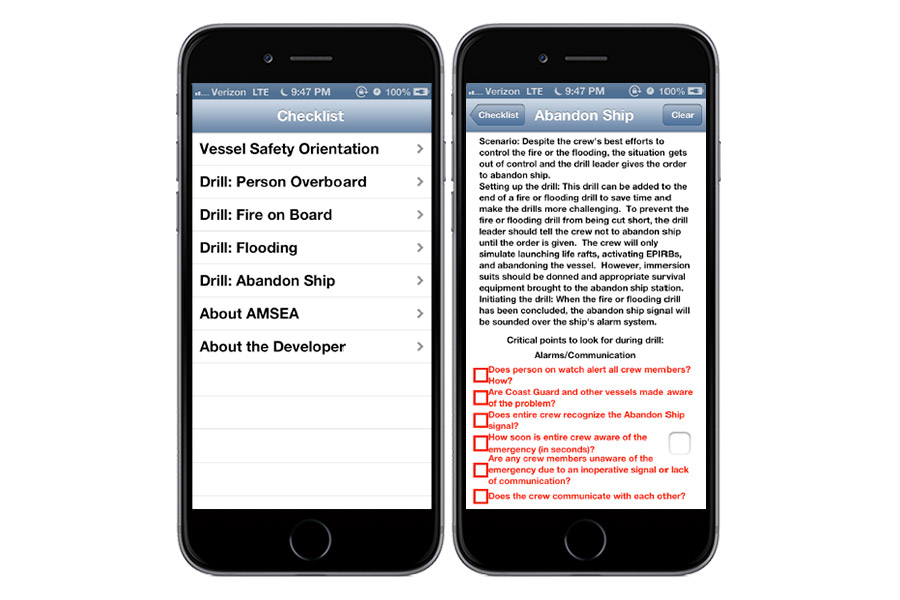Refinement of the fishing vessel drills (FVdrills) safety iOS application
Figure 1: Sample screen captures from FVdrills, "Checklist" (left) and "Drill: Abandon Ship" page (right) in iPhone 6 (simulated)

Goals & Objectives
Commercial fishing has long been one of the the most dangerous jobs in the United States. The value of safety training in commercial fleets has been discussed and regulatory agencies have recognized the importance of conducting monthly fishing vessel (FV) drills. For example, the United States Coast Guard requires an appropriately trained fishing vessel drill conductor aboard and each crew member’s participation in monthly drills (CFR 28.270).
In support of an application-based approach to maritime occupational safety interventions, the PI Leigh McCue-Weil teamed up with Jerry Dzugan (Co-Investigator) to develop an iOS-based drill checklist app FVdrills. The content of the drills was mainly adapted from the book “Beating the Odds on Northern Waters” (Jensen & Dzugan, 2009) by Alaska Marine Safety Education Association (AMSEA). The initial development of FVdrills was supported as the Kevin P. Granata Pilot Research Program. The FVdrills app was released in February 2013 and primary feedback from fishermen indicated broad support of the application. The app has 529 worldwide users on six continents as of July 2014.
The research team hypothesized that enabling portability of the drill checklist as an app will encourage compliance as maritime workers find that adopting to the life-saving regulations is both low-cost and improves safety. Figure 1 shows sample screen captures of the FVdrills.
The main goal of this project is to improve the FVdrills app so it will be more deployable for fishing safety. There are two fundamental objectives on this study:
- Incorporate anecdotal feedback by fishermen and commercial vessel operators into the FVdrills.
- Conduct a preliminary assessment effort upon which to base a more comprehensive assessment effort.
Project Approach & Activities
The aforementioned objectives will be conducted in sequence. For Objective 1, the FVdrills will be revised for enhancement by incorporating valuable constructive input that the PI and Jerry Dzugan have received through visits with fishermen and other commercial vessel operators. Input examples include enabling emailing results of drills and maintaining a digital log of Emergency Position-Indicating Radio Beacon (EPIRB).
For Objective 2, the research team will conduct a preliminary assessment by utilizing AMSEA's fishermen network throughout the United States, and Co-Investigator Maria Bulzacchelli's expertise in evaluation to develop an appropriate survey instrument. It is anticipated that the survey will collect demographic data, user information (e.g., fishery type), short questions about the perceived benefit, user-friendliness, and general user feedback on the revised FVdrills.
Faculty and Facility
PI: Leigh McCue-Weil; Co-Is: Jerry Dzugan (Alaska Marine Safety Education Association), Maria T. Bulzacchelli (University of Massachusetts, Amherst)
Funding Source
“Refinement of the fishing vessel drills (FVdrills) safety iOS application,” The Northeast Center for Agricultural, Forestry and Fishing Safety and Health (NEC) (08/15/14 – 08/14/15) PI: L. McCue-Weil.
Sector: Fishing
Discipline: Safety
PI: Leigh McCue-Weil (Virginia Tech)
Co-Is: Jerry Dzugan (Alaska Marine Safety Education Association), Maria T. Bulzacchelli (University of Massachusetts, Amherst)


